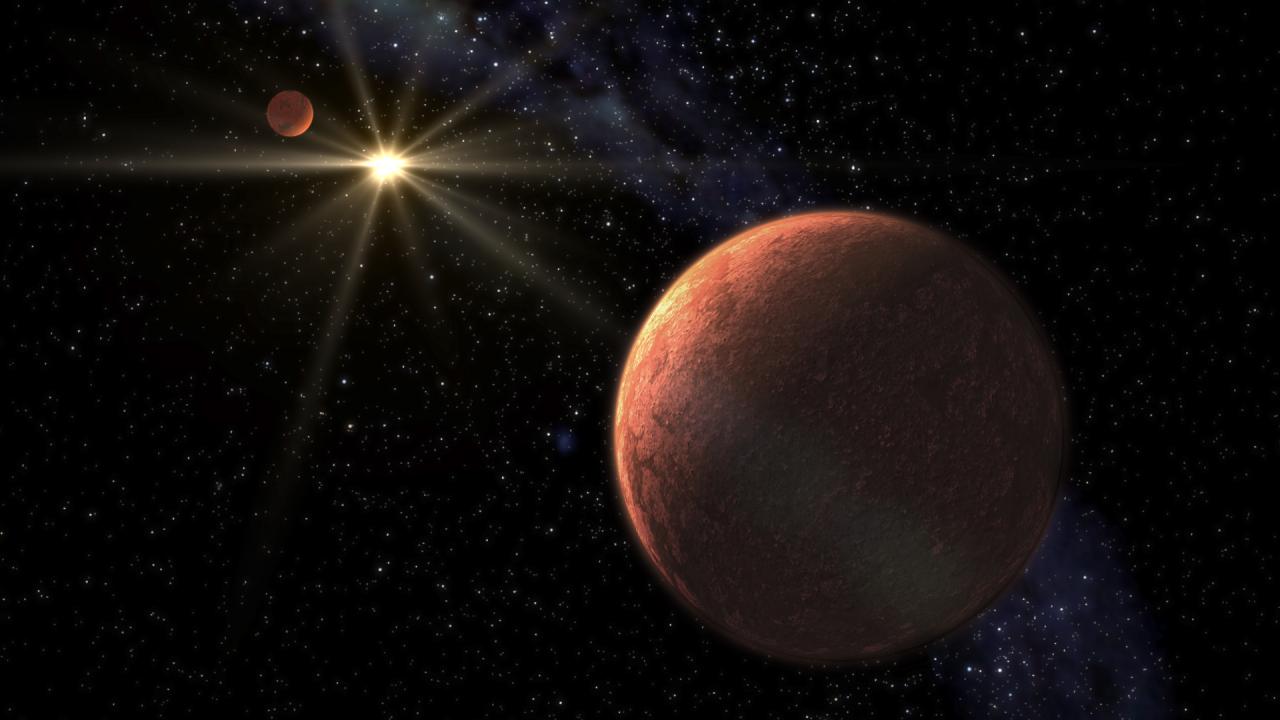Subvenciones relacionadas:
General
Se investigan los procesos que conducen a la formación de estrellas de baja masa, enanas marrones y exoplanetas y caracterizar las propiedades físicas de estos astros en varias etapas evolutivas. Las estrellas de muy baja masa y las enanas marrones son probablemente los objetos más numerosos de nuestra Galaxia, pero no por ello están suficientemente bien establecidas sus propiedades. En particular, los objetos subestelares constituyen uno de los grupos más difíciles de estudiar desde el punto de vista observacional dada su baja luminosidad intrínseca. Se pretende establecer la frecuencia, multiplicidad y distribución espacial de estrellas ultrafrías y objetos subestelares en la vecindad del Sol y en regiones de formación estelar y cúmulos cercanos con el fin de proporcionar información sobre los mecanismos que los originan, caracterizar sus propiedades ópticas e infrarrojas, y establecer relaciones entre sus propiedades espectrales, masas y luminosidades. Se hace especial énfasis en empujar la frontera de detección hacia los objetos de menor masa, bien sea como objetos ligados por atracción gravitatoria a otros, o flotando libremente en el espacio interestelar. Los objetos menos masivos también suelen ser los de menor luminosidad intrínseca y temperaturas superficiales más frías por lo que entrañan notable dificultad de detección por medio de imagen directa. Sin embargo, la detección directa permite una caracterización fotométrica y espectroscópica mucho más completa y una mejor determinación de sus propiedades físicas y químicas. También se pretende investigar la presencia de exoplanetas en estrellas de baja masa empleando técnicas de medida de velocidad radial con muy alta precisión y técnicas de muy alta resolución espacial. Se trabaja en el desarrollo de espectrógrafos ultraestables para grandes telescopios y de sistemas de imagen ultrarrápida. Con los primeros es posible lograr la detección de planetas con masas similares a la de la Tierra en estrellas de tipos G, K y M un objetivo que se persigue es establecer la frecuencia de estos planetas en las estrellas de la vecindad solar y caracterizar las propiedades de los sistemas planetarios a los que pertenecen.
Miembros
Resultados
- La secuencia visible y infrarroja de las enanas de tipo L de 10 Myr de edad en la asociación OB mas cercana al Sol, Upper Scorpius
- El limite estelar/subestelar del cumulo más cercano al Sol, las Hiades
Actividad científica
Publicaciones relacionadas
-
Wide companions to M and L subdwarfs with Gaia and the Virtual Observatory
Aims: The aim of the project is to identify wide common proper motion companions to a sample of spectroscopically confirmed M and L metal-poor dwarfs (also known as subdwarfs) to investigate the impact of metallicity on the binary fraction of low-mass metal-poor binaries and to improve the determination of their metallicity from the higher-mass
González-Payo, J. et al.Fecha de publicación:
62021 -
The CARMENES search for exoplanets around M dwarfs. Mapping stellar activity indicators across the M dwarf domain
Context. Stellar activity poses one of the main obstacles for the detection and characterisation of small exoplanets around cool stars, as it can induce radial velocity (RV) signals that can hide or mimic the presence of planetary companions. Several indicators of stellar activity are routinely used to identify activity-related signals in RVs, but
Lafarga, M. et al.Fecha de publicación:
82021 -
HADES RV programme with HARPS-N at TNG. XIV. A candidate super-Earth orbiting the M-dwarf GJ 9689 with a period close to half the stellar rotation period
Context. It is now well-established that small, rocky planets are common around low-mass stars. However, the detection of such planets is challenged by the short-term activity of host stars. Aims: The HARPS-N red Dwarf Exoplanet Survey programme is a long-term project at the Telescopio Nazionale Galileo aimed at monitoring nearby, early-type, M
Maldonado, J. et al.Fecha de publicación:
72021 -
Simultaneous photometric and CARMENES spectroscopic monitoring of fast-rotating M dwarf GJ 3270. Discovery of a post-flare corotating feature
Context. Active M dwarfs frequently exhibit large flares, which can pose an existential threat to the habitability of any planet in orbit in addition to making said planets more difficult to detect. M dwarfs do not lose angular momentum as easily as earlier-type stars, which maintain the high levels of stellar activity for far longer. Studying
Johnson, E. N. et al.Fecha de publicación:
72021 -
The CARMENES search for exoplanets around M dwarfs. Two terrestrial planets orbiting G 264-012 and one terrestrial planet orbiting Gl 393
We report the discovery of two planetary systems, namely G 264-012, an M 4.0 dwarf with two terrestrial planets (M b sin i=2.50 −0.30 +0.29 M ⊕ and M c sin i=3.75 −0.47 +0.48 M ⊕), and Gl 393, a bright M 2.0 dwarf with one terrestrial planet (M b sini = 1.71 ± 0.24M ⊕). Although both stars were proposed to belong to young stellar kinematic groups
Amado, P. J. et al.Fecha de publicación:
62021 -
An ultra-short-period transiting super-Earth orbiting the M3 dwarf TOI-1685
Dynamical histories of planetary systems, as well as the atmospheric evolution of highly irradiated planets, can be studied by characterizing the ultra-short-period planet population, which the TESS mission is particularly well suited to discover. Here, we report on the follow-up of a transit signal detected in the TESS sector 19 photometric time
Bluhm, P. et al.Fecha de publicación:
62021 -
ESPRESSO mass determination of TOI-263b: an extreme inhabitant of the brown dwarf desert
The TESS mission has reported a wealth of new planetary systems around bright and nearby stars amenable for detailed characterizations of planet properties and atmospheres. However, not all interesting TESS planets orbit around bright host stars. TOI-263 b is a validated ultra-short-period substellar object in a 0.56-day orbit around a faint (V =
Palle, E. et al.Fecha de publicación:
62021 -
Mass and density of the transiting hot and rocky super-Earth LHS 1478 b (TOI-1640 b)
One of the main objectives of the Transiting Exoplanet Survey Satellite (TESS) mission is the discovery of small rocky planets around relatively bright nearby stars. Here, we report the discovery and characterization of the transiting super-Earth planet orbiting LHS 1478 (TOI-1640). The star is an inactive red dwarf (J ~ 9.6 mag and spectral type
Soto, M. G. et al.Fecha de publicación:
52021 -
HADES RV Programme with HARPS-N at TNG. XIII. A sub-Neptune around the M dwarf GJ 720 A
Context. The high number of super-Earth and Earth-like planets in the habitable zone detected around M-dwarf stars in recent years has revealed these stellar objects to be the key to planetary radial velocity (RV) searches. Aims: Using the HARPS-N spectrograph within The HArps-n red Dwarf Exoplanet Survey (HADES) we have reached the precision
González-Álvarez, E. et al.Fecha de publicación:
52021 -
Weighing stars from birth to death: mass determination methods across the HRD
The mass of a star is the most fundamental parameter for its structure, evolution, and final fate. It is particularly important for any kind of stellar archaeology and characterization of exoplanets. There exist a variety of methods in astronomy to estimate or determine it. In this review we present a significant number of such methods, beginning
Serenelli, Aldo et al.Fecha de publicación:
122021 -
A transmission spectrum of the planet candidate WD 1856+534 b and a lower limit to its mass
The cool white dwarf WD 1856+534 was found to be transited by a Jupiter-sized object with a mass at or below 14 M Jup. We used the GTC telescope to obtain and analyse the photometry and low-resolution spectroscopy of six transits of WD 1856+534 b, with the intention of deriving the slope of the transmission spectrum. Such a slope, assuming a cloud
Alonso, R. et al.Fecha de publicación:
52021 -
The CARMENES search for exoplanets around M dwarfs. No evidence for a super-Earth in a 2-day orbit around GJ 1151
Context. The interaction between Earth-like exoplanets and the magnetic field of low-mass host stars are considered to produce weak emission signals at radio frequencies. A study using LOFAR data announced the detection of radio emission from the mid M-type dwarf GJ 1151 that could potentially arise from a close-in terrestrial planet. Recently, the
Ribas, I. et al.Fecha de publicación:
52021 -
Six transiting planets and a chain of Laplace resonances in TOI-178
Determining the architecture of multi-planetary systems is one of the cornerstones of understanding planet formation and evolution. Resonant systems are especially important as the fragility of their orbital configuration ensures that no significant scattering or collisional event has taken place since the earliest formation phase when the parent
Leleu, A. et al.Fecha de publicación:
52021 -
A sub-Neptune and a non-transiting Neptune-mass companion unveiled by ESPRESSO around the bright late-F dwarf HD 5278 (TOI-130)
Context. Transiting sub-Neptune-type planets, with radii approximately between 2 and 4 R ⊕, are of particular interest as their study allows us to gain insight into the formation and evolution of a class of planets that are not found in our Solar System. Aims: We exploit the extreme radial velocity (RV) precision of the ultra-stable echelle
Sozzetti, A. et al.Fecha de publicación:
42021 -
A super-Earth on a close-in orbit around the M1V star GJ 740. A HADES and CARMENES collaboration
Context. M-dwarfs have proven to be ideal targets for planetary radial velocity (RV) searches due to their higher planet-star mass contrast, which favors the detection of low-mass planets. The abundance of super-Earth and Earth-like planets detected around this type of star motivates further such research on hosts without reported planetary
Toledo-Padrón, B. et al.Fecha de publicación:
42021 -
Exploring the planetary-mass population in the Upper Scorpius association
We aim at identifying very low-mass isolated planetary-mass member candidates in the nearest OB association to the Sun, Upper Scorpius (USco) (145 pc; 5-10 Myr), to constrain the form and shape of the luminosity function and mass spectrum in this regime. We conducted a deep multiband (Y = 21.2, J = 20.5, Z = 22.0 mag) photometric survey of 6 deg 2
Lodieu, N. et al.Fecha de publicación:
52021 -
A nearby transiting rocky exoplanet that is suitable for atmospheric investigation
Spectroscopy of transiting exoplanets can be used to investigate their atmospheric properties and habitability. Combining radial velocity (RV) and transit data provides additional information on exoplanet physical properties. We detect a transiting rocky planet with an orbital period of 1.467 days around the nearby red dwarf star Gliese 486. The
Trifonov, T. et al.Fecha de publicación:
32021 -
The atmosphere of HD 209458b seen with ESPRESSO. No detectable planetary absorptions at high resolution
We observed two transits of the iconic gas giant HD 209458b between 380 and 780 nm, using the high-resolution ESPRESSO spectrograph. The derived planetary transmission spectrum exhibits features at all wavelengths where the parent star shows strong absorption lines, for example, Na I, Mg I, Fe I, Fe II, Ca I, V I, Hα, and K I. We interpreted these
Casasayas-Barris, N. et al.Fecha de publicación:
32021 -
Fundamental physics with ESPRESSO: Towards an accurate wavelength calibration for a precision test of the fine-structure constant
Observations of metal absorption systems in the spectra of distant quasars allow one to constrain a possible variation of the fine-structure constant throughout the history of the Universe. Such a test poses utmost demands on the wavelength accuracy and previous studies were limited by systematics in the spectrograph wavelength calibration. A
Schmidt, Tobias M. et al.Fecha de publicación:
22021 -
ESPRESSO high-resolution transmission spectroscopy of WASP-76 b
Aims: We report on ESPRESSO high-resolution transmission spectroscopic observations of two primary transits of the highly irradiated, ultra-hot Jupiter-sized planet, WASP-76b. We investigated the presence of several key atomic and molecular features of interest that may reveal the atmospheric properties of the planet. Methods: We extracted two
Tabernero, H. M. et al.Fecha de publicación:
22021



